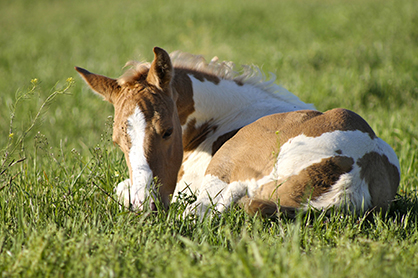Measuring Foal IgG: How and When
Foals possess the ability to produce infection-fighting antibodies, called immunoglobulins or Igs, from the moment they’re born. What they don’t possess is pre-existing Igs in their bloodstream at the time of birth to protect them from the onslaught of bacteria and other infection-inducing microorganisms in their new environment.
“This lack of maternal transfer of immunity is somewhat of an evolutionary drawback, leaving foals highly susceptible to threatening infections, especially, pneumonia, joint infections, and sepsis,” noted Kathleen Crandell, Ph.D., a Kentucky Equine Research nutritionist.
Foals therefore require a healthy meal of colostrum—the mare’s first milk laden with Igs to temporarily provide immunity until the foal’s own immune system swings into full gear. But when do you say whoa, or should a foal drink to his heart’s desire? Here’s what you need to know about the process of passive transfer of immunity:
- Time is of the essence. A foal loses its ability to absorb Igs after 18-24 hours.
- Assisting foals to stand and encouraging them to nurse from their dam as soon as possible after birth will decrease the risk of failure of passive transfer.
- Allow them to nurse as frequently as they wish.
- If the mare begins leaking colostrum prior to the foal nursing, collect the colostrum and bottle feed it to the foal instead. Alternatively, have some frozen colostrum (available commercially) for back-up purposes.
- Measure the foal’s Ig (IgG, specifically) levels between 18 and 24 hours of life to ensure sufficient passive transfer has been achieved. Ideally, IgG levels exceed 8 grams/liter.
“Several methods of measuring IgGs to ensure sufficient immunity exist, each with some pros and cons. One recent study* conducted over a five-year period found that all three of the tested techniques proved sufficiently capable of diagnosing failure of passive transfer in neonatal foals,” shared Crandell.
Some examples of these tests include two laboratory tests called a radial immunodiffiusion assay (RID) and electrophoreses. RID is currently the “gold standard,” with electrophoresis coming in a close second; however, specialized equipment is required and the results take about 24 hours. Stall-side assays using handheld instruments called refractometers are available. These refractometers also have some drawbacks, but they appear to be valid and useful tools for the rapid, inexpensive screening of successful passive transfer of immunity.
“To add more bang to your mare’s colostrum, ensure her overall nutritional needs are being met and begin supplementing her with omega-3 fatty acids. This supports not only the mare during gestation but also the foal’s ocular and cognitive development early in life,” Crandell added.
Kentucky Equine Research’s EO-3 contains a concentrated, palatable source of both DHA and EPA. EO-3 is easily top-dressed on the mare’s feed.
*Elsohaby, I., C.B. Riley, J.T. McClure. Usefulness of digital and optical refractometers for the diagnosis of failure of transfer of passive immunity in neonatal foals. Equine Veterinary Journal. In press.











